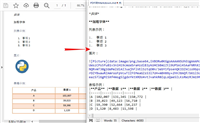一、词嵌入(word embedding)简介
词嵌入是自然语言处理(nlp)中的一项核心技术,它将离散的词语映射到连续的向量空间中。通过词嵌入,语义相似的词语在向量空间中的位置也会相近。
为什么需要词嵌入?
解决维度灾难:传统one-hot编码维度等于词汇表大小,而词嵌入维度可自定义
捕捉语义关系:通过向量空间中的距离反映词语间的语义关系
迁移学习:预训练的词嵌入可以在不同任务间共享
二、pytorch中的nn.embedding详解
1. nn.embedding基础
nn.embedding是pytorch中实现词嵌入的核心模块,本质上是一个查找表,将整数索引(代表词语)映射到固定维度的稠密向量。
import torch import torch.nn as nn # 基本使用示例 embedding = nn.embedding(num_embeddings=10, embedding_dim=5) # num_embeddings: 词汇表大小 # embedding_dim: 词向量维度 input = torch.longtensor([1, 2, 3]) # 3个词的索引 output = embedding(input) print(output.shape) # torch.size([3, 5])
2. nn.embedding参数详解
torch.nn.embedding(
num_embeddings,
embedding_dim,
padding_idx=none,
max_norm=none,
norm_type=2.0,
scale_grad_by_freq=false,
sparse=false,
_weight=none,
_freeze=false,
device=none,
dtype=none
)重要参数解释:
num_embeddings (int): 词汇表的大小,即最大整数索引+1
embedding_dim (int): 每个词向量的维度
padding_idx (int, optional): 如果指定,此索引处的向量将全为0且在训练中不会更新
max_norm (float, optional): 如果指定,超过此范数的向量将被重新归一化
norm_type (float, optional): 为max_norm计算p-norm时的p值,默认为2
scale_grad_by_freq (bool, optional): 如果为true,将根据单词在batch中的频率缩放梯度
sparse (bool, optional): 如果为true,使用稀疏梯度更新权重矩阵
3. 初始化与预训练词嵌入
# 随机初始化 embedding = nn.embedding(100, 50) # 100个词,每个词50维 # 使用预训练词向量 pretrained_weights = torch.randn(100, 50) # 模拟预训练权重 embedding = nn.embedding.from_pretrained(pretrained_weights)
4. 使用padding_idx处理变长序列
embedding = nn.embedding(100, 50, padding_idx=0) # 假设0是padding的索引 input = torch.longtensor([[1, 2, 3, 0], [4, 5, 0, 0]]) # batch_size=2, seq_len=4 output = embedding(input) print(output.shape) # torch.size([2, 4, 50])
三、实战应用示例
1. 基础文本分类模型
import torch
import torch.nn as nn
class textclassifier(nn.module):
def __init__(self, vocab_size, embed_dim, num_classes):
super(textclassifier, self).__init__()
self.embedding = nn.embedding(vocab_size, embed_dim)
self.fc = nn.linear(embed_dim, num_classes)
def forward(self, x):
# x shape: (batch_size, seq_len)
embedded = self.embedding(x) # (batch_size, seq_len, embed_dim)
# 取序列中所有词向量的平均值
pooled = embedded.mean(dim=1) # (batch_size, embed_dim)
out = self.fc(pooled)
return out
# 使用示例
model = textclassifier(vocab_size=10000, embed_dim=300, num_classes=5)
input = torch.longtensor([[1, 2, 3], [4, 5, 0]]) # batch_size=2, seq_len=3
output = model(input)
print(output.shape) # torch.size([2, 5])2. 结合lstm的序列模型
class lstmmodel(nn.module):
def __init__(self, vocab_size, embed_dim, hidden_dim, num_layers, num_classes):
super(lstmmodel, self).__init__()
self.embedding = nn.embedding(vocab_size, embed_dim)
self.lstm = nn.lstm(embed_dim, hidden_dim, num_layers, batch_first=true)
self.fc = nn.linear(hidden_dim, num_classes)
def forward(self, x):
# x shape: (batch_size, seq_len)
embedded = self.embedding(x) # (batch_size, seq_len, embed_dim)
lstm_out, (h_n, c_n) = self.lstm(embedded) # lstm_out: (batch_size, seq_len, hidden_dim)
# 取最后一个时间步的输出
out = self.fc(lstm_out[:, -1, :])
return out
# 使用示例
model = lstmmodel(vocab_size=10000, embed_dim=300, hidden_dim=128,
num_layers=2, num_classes=5)
input = torch.longtensor([[1, 2, 3, 4], [5, 6, 0, 0]]) # batch_size=2, seq_len=4
output = model(input)
print(output.shape) # torch.size([2, 5])3. 可视化词嵌入
import matplotlib.pyplot as plt
from sklearn.manifold import tsne
def visualize_embeddings(embedding_layer, word_to_idx, words):
# 获取词向量
indices = torch.longtensor([word_to_idx[word] for word in words])
vectors = embedding_layer(indices).detach().numpy()
# 使用t-sne降维
tsne = tsne(n_components=2, random_state=42)
vectors_2d = tsne.fit_transform(vectors)
# 可视化
plt.figure(figsize=(10, 8))
for i, word in enumerate(words):
plt.scatter(vectors_2d[i, 0], vectors_2d[i, 1])
plt.annotate(word, xy=(vectors_2d[i, 0], vectors_2d[i, 1]))
plt.show()
# 示例词汇
words = ["king", "queen", "man", "woman", "computer", "data"]
word_to_idx = {word: i for i, word in enumerate(words)}
# 创建嵌入层
embedding = nn.embedding(len(words), 50)
# 可视化
visualize_embeddings(embedding, word_to_idx, words)四、高级技巧与注意事项
1. 冻结词嵌入层
# 冻结嵌入层参数(不更新) embedding = nn.embedding(1000, 300) embedding.weight.requires_grad = false # 或者使用from_pretrained时直接冻结 pretrained = torch.randn(1000, 300) embedding = nn.embedding.from_pretrained(pretrained, freeze=true)
2. 处理oov(out-of-vocabulary)问题
# 方法1: 使用unk token
vocab = {"<unk>": 0, ...} # 将未知词映射到0
embedding = nn.embedding(len(vocab), 300, padding_idx=0)
# 方法2: 随机初始化
unk_vector = torch.randn(300) # 为oov词准备的特殊向量3. 结合预训练词向量
def load_pretrained_embeddings(word_to_idx, embedding_file, embedding_dim):
# 创建权重矩阵
embedding_matrix = torch.zeros(len(word_to_idx), embedding_dim)
# 加载预训练词向量(这里以glove格式为例)
with open(embedding_file, 'r', encoding='utf-8') as f:
for line in f:
values = line.split()
word = values[0]
if word in word_to_idx:
idx = word_to_idx[word]
vector = torch.tensor([float(val) for val in values[1:]])
embedding_matrix[idx] = vector
return nn.embedding.from_pretrained(embedding_matrix)
# 使用示例
word_to_idx = {"hello": 0, "world": 1, ...} # 你的词汇表
embedding = load_pretrained_embeddings(word_to_idx, 'glove.6b.100d.txt', 100)五、常见问题解答
q1: 如何选择词向量的维度?
a: 一般经验值:
小型数据集:50-100维
中型数据集:200-300维
大型数据集:300-500维
也可以尝试不同维度比较模型性能
q2: 什么时候应该使用预训练词向量?
a:
当你的训练数据较少时
当你的任务与预训练语料领域相似时
当你没有足够的计算资源从头训练时
q3: padding_idx和masking有什么区别?
a:
padding_idx只是将特定索引的向量设为零且不更新
masking则是完全忽略这些位置,不参与计算(如在rnn中)
q4: 如何更新预训练词向量?
a:
embedding = nn.embedding.from_pretrained(pretrained_weights, freeze=false) # 设置freeze=false
六、总结
pytorch中的nn.embedding为nlp任务提供了灵活高效的词嵌入实现。通过本教程,你应该已经掌握了:
nn.embedding的基本原理和使用方法各种参数的详细解释和配置技巧
在实际模型中的应用示例
高级技巧如冻结参数、处理oov等
词嵌入是nlp的基础组件,合理使用可以显著提升模型性能。建议在实践中多尝试不同的配置和预训练词向量,找到最适合你任务的组合。
到此这篇关于pytorch中的词嵌入层(nn.embedding)详解与实战应用示例的文章就介绍到这了,更多相关pytorch词嵌入内容请搜索代码网以前的文章或继续浏览下面的相关文章希望大家以后多多支持代码网!







发表评论